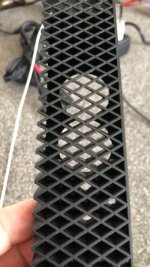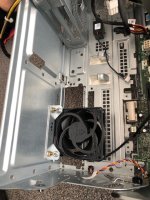correct 👍Flat on the bottom sucking fresh air from below through large enough slots creating overpressure in the device and therefor blowing out hot air through ventilation slots at the back and those at the sides. Probably a non perfect way but at least (...)
Unfortunately, this is not a real hi-fi solution and requires considerable modification work on the housing; then you might as well do it properly - everyone knows what that means -> DIY.
It is however a real useful life prolonging method and not too hard to implement. I do such stuff a lot with hot devices except that I prefer passive methods normally, very rewarding. Metal work is Zen for the soul.
There simply is no way to implement correct heatsinking without disturbing its landmark appearance.
There simply is no way to implement correct heatsinking without disturbing its landmark appearance.
I have never come across this case in my time in the wannabe high-end scene (Kadett E driver vs. Golf driver ) when I was still repairing A1 for them.The old ones are one of the shining examples of burning woofer syndrome.
Often written but repeated: I had one for repair when I noticed DC at the outputs and a very hot cap. I understood this was not OK and when I wanted to pull the plug in a reflex one of the caps exploded and was launched too close to my head. Its traject was against the ceiling. Room littered with foil and paper. That was the moment I decided to refuse repairing these anymore.
Agreed, the heat dissipation inside a case by means of one or more fans requires in my view a more scientific and not approximate approach.If anyone thinks that installing a low-noise fan is the solution, they are mistaken, because how is the laminar flow (necessary for the A1) to be generated?
In my opinion inside the A1 case the fan would be without a doubt too small and therefore with too little air flow to demonstrate any effectiveness.
And in any case, no more than one would fit and in that case it should have an extractive flow in my opinion.
But it should also have a quantity of slots sufficient to feed the air flow of the fan and to let fresh air into the amplifier.
https://www.diyaudio.com/community/threads/babysitter-for-papas-koan.186554/page-6
As said, it is not something that can be done in an approximate way, if one wants to obtain noteworthy results.
https://www.neweggbusiness.com/smartbuyer/over-easy/pc-cooling-how-to-set-up-computer-case-fans/
At that point, a large external fan blowing cool air onto the boiling "heat sink" would be more rational (however, it wouldn't be my choice anyway), also because the larger the diameter of a fan, the smaller the noise it generates for the same air flow.
Post #100: 60 x 60, 70 x 70 or 80 x 80? Larger is better. Sunon maglev is good. BTW 1 fan is a necessary evil, adding 2 fans is SM. Some therefor prefer non class A as excess heat, high energy consumption, shorter lifetime and now the need to add fans all really are a nuisance except when one likes the sound of air flow over music while checking the energy bill. An external fan is in my strong opinion a dealbreaker making the A1 a non desired device.
Changing that chassis is done in 2 hours max. provided that the PCB has no tracks at that spot.
Changing that chassis is done in 2 hours max. provided that the PCB has no tracks at that spot.
Last edited:
Post #100: 60 x 60, 70 x 70 or 80 x 80? Larger is better. Sunon maglev is good. BTW 1 fan is a necessary evil, adding 2 fans is SM. Some therefor prefer non class A as excess heat, high energy consumption, shorter lifetime and now the need to add fans all really are a nuisance except when one likes the sound of air flow over music while checking the energy bill. An external fan is in my strong opinion a dealbreaker making the A1 a non desired device.
Mine was obviously a hypothetical example, I would never even dream of putting a small fan inside the case of an A1 (just because I'm absolutely convinced that it would be completely useless), let alone two! 😉
So, should I buy an integrated amplifier like A1 and then take on the burden of changing the case, making all the necessary openings, calculating and searching for and finding the right heat sinks, redoing all the connections and who knows what else?Changing that chassis is done in 2 hours max. provided that the PCB has no tracks at that spot.
I don't agree, even though someone on this thread posted an admirable example of this in two separate mono cases (if I saw correctly).
But, after all that changes, will all that magic sound will remain like the original?
No, not for me.
This is my hobby with cheap Chinese devices. Solve design errors, mitigate heat issues, weed out fake parts, improve power supplies, prolong lifetime. Real Zen.
Not with 1599 Euro devices that still smell new. It can be done in case someone is as stubborn.
Not with 1599 Euro devices that still smell new. It can be done in case someone is as stubborn.
No way, to many tracks there!Changing that chassis is done in 2 hours max. provided that the PCB has no tracks at that spot.
Maybe there will be an upgrade in the old Project Audio style "Cool-It", a new lid for 345 € ..! I would really like to know what the German importer thinks about this crap?
1. No space for enough 4 or (better) 6 mm holes?
2. No space for just 4 mounting holes for an elevated fan mounted on standoffs or rubber grommets to the PCB?
Even just mechanical air flow from the sides can be adequate.
2. No space for just 4 mounting holes for an elevated fan mounted on standoffs or rubber grommets to the PCB?
Even just mechanical air flow from the sides can be adequate.
The magical sound is a peculiarity of the rather strange circuit of the Tim de Paravincini design.But, after all that changes, will all that magic sound will remain like the original?
Actually, no EE would come up with the idea of building a power amp like this.
No!1. No space for enough 4 or (better) 6 mm holes?
2. No space for just 4 mounting holes for an elevated fan mounted on standoffs or rubber grommets to the PCB?
Circuit tracks drilled through three times.
But a fan at this point would only cause turbulence anyway ...
coffee break ☕
Of course:
Drill a blind hole in the lid, cut a thread, mount the fan on the lid -> that works. I already said "Cool-It the upgrade kit" 🤣
Drill a blind hole in the lid, cut a thread, mount the fan on the lid -> that works. I already said "Cool-It the upgrade kit" 🤣
May be, but I said something else.The magical sound is a peculiarity of the rather strange circuit of the Tim de Paravincini design.
Actually, no EE would come up with the idea of building a power amp like this.
I was simply wondering if after doing all that described above in order to replace the current insipid case of an A1 there was then the risk of causing some deterioration to the original sound.
Generally speaking I'm for respecting the integrity of the design and usually I focus my modifications on what can be improved without probably altering the final SQ.
Since, except for a few cases, I find it rather presumptuous to pretend to improve something that a designer has created and of which I already like the resulting sound.
Very often I have seen the exact opposite happen.
Very often I have seen design errors based on assumptions, human error or neglect that could be solved in minutes by just thinking of a better solution. I have also seen such in medical devices and professional high power environments. Worse are correctly designed devices implemented in a wrong way or adapted to a wrong assumption. I liked the situation where a large UPS was connected with its output to solar panels. Here it was assumed by consultants with impressive egos, suits and diplomas that the existing UPS was able to feed back energy to the mains 😀
If the device sounds best by having a too short life and becoming too hot and me accepting that then I would doubt myself, not the product. Many that follow "names", brands or made up reputations like to think that these are some superintelligent extremely gifted talents or even genius but truth is we all make mistakes and thinking errors. This particular device is, just like its predecessor, full of mistakes whether is it designed by Kanye West or someone from a slum.
In my professional projects I always ask complete laymen and/or "other skilled" persons for input. It is surprising how many good ideas can come from those that are not supposed to know.
If the device sounds best by having a too short life and becoming too hot and me accepting that then I would doubt myself, not the product. Many that follow "names", brands or made up reputations like to think that these are some superintelligent extremely gifted talents or even genius but truth is we all make mistakes and thinking errors. This particular device is, just like its predecessor, full of mistakes whether is it designed by Kanye West or someone from a slum.
In my professional projects I always ask complete laymen and/or "other skilled" persons for input. It is surprising how many good ideas can come from those that are not supposed to know.
Last edited:
thats is what you can buy ....you know that big boys can have a custom part ??It seems that the temperatures reached inside the case will easily make the pot (gear) go beyond the limits imposed by its design as from Alps spec.
In other words, it simply seems yet another bad choice by the designer(s), or a consequence of it (that's the overheating). 😉
View attachment 1338014
if is fault unit ask for new ones quite simple
I think that if any component is forced to work outside of its operating temperature range then it is not a fault of that component if it breaks, it is the designer who have inevitably caused it to fail.if is fault unit ask for new ones quite simple
Furthermore, no manufacturer's warranty covers that kind of "fail".
it is your idea as you DO NOT know the pot used nor if is alps , btw 70° on datasheet you posted the amp work at 60° quite normal for classA in summer
for 1500€ you can't have more be happy tha you can buy the MF is great amp
please a fan isn't a rocket science
for 1500€ you can't have more be happy tha you can buy the MF is great amp
please a fan isn't a rocket science
Last edited:
- Home
- Amplifiers
- Solid State
- 2023 Musical Fidelity A1

